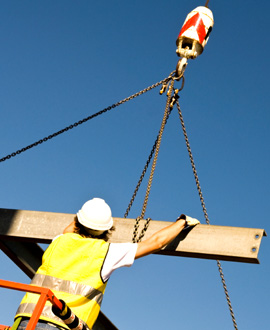
Subpart CC - Cranes and Derricks in Construction: Qualified Rigger
This fact sheet describes the qualified rigger requirements of subpart CC - Cranes and Derricks in Construction, as specified in 29 CFR 1926.1401, 1926.1404, and 1926.1425. These provisions are effective November 8, 2010.
When is a qualified rigger required?
Employers must use qualified riggers during hoisting activities for assembly and disassembly work (1926.1404(r)(1)). Additionally, qualified riggers are required whenever workers are within the fall zone and hooking, unhooking, or guiding a load, or doing the initial connection of a load to a component or structure (1926.1425(c)).
Who can be a qualified rigger?
A qualified rigger is a rigger who meets the criteria for a qualified person. Employers must determine whether a person is qualified to perform specific rigging tasks. Each qualified rigger may have different credentials or experience. A qualified rigger is a person that:
- Possesses a recognized degree, certificate, or professional standing, or
- Has extensive knowledge, training, and experience, and
- Can successfully demonstrate the ability to solve problems related to rigging loads.
The person designated as the qualified rigger must have the ability to properly rig the load for a particular job. It does not mean that a rigger must be qualified to do every type of rigging job.
Each load that requires rigging has unique properties that can range from the simple to the complex. For example, a rigger may have extensive experience in rigging structural components and other equipment to support specific construction activities. Such experience may have been gained over many years. However, this experience does not automatically qualify the rigger to rig unstable, unusually heavy, or eccentric loads that may require a tandem lift, multiple-lifts, or use of custom rigging equipment. In essence, employers must make sure the person can do the rigging work needed for the exact types of loads and lifts for a particular job with the equipment and rigging that will be used for that job.
Do qualified riggers have to be trained or certified by an accredited organization or assessed by a third party?
No. Riggers do not have to be certified by an accredited organization or assessed by a third party. Employers may choose to use a third party entity to assess the qualifications of the rigger candidate, but they are not required to do so.
Does a certified operator also meet the requirements of a qualified rigger?
A certified operator does not necessarily meet the requirements of a qualified rigger. Determining whether a person is a qualified rigger is based on the nature of the load, lift, and equipment used to hoist that load plus that person's knowledge and experience. A certified/qualified operator may meet the requirements of a qualified rigger, depending on the operator's knowledge and experience with rigging.
OSTS' Qualified Rigger solution
Depending on the level of experience and the number of students per class, the class duration can range from 4 to 6 hours. This class is intended to train personnel to identify the various types of rigging equipment and safe rigging practices.
The class will provide the student with an understanding of the fundamentals of rigging and the ability to identify potential safety problems.
Topics to be discussed are:
- Proper rigging technique in the use of rigging equipment
- Sling angle factor
- Regulations (OSHA Subpart CC and ASME B30.5, B30.2, and B30.3)
- Pick point
- Center of gravity
- Proper tools for the proper job
- Hook inspection
- Wire rope inspection
- Shackle inspection
- Estimating weight
- Knots tying, and
- Hands-On evaluation
Call 1 877 226-6006 and ask for Gregg or request more information through our Contact Form
